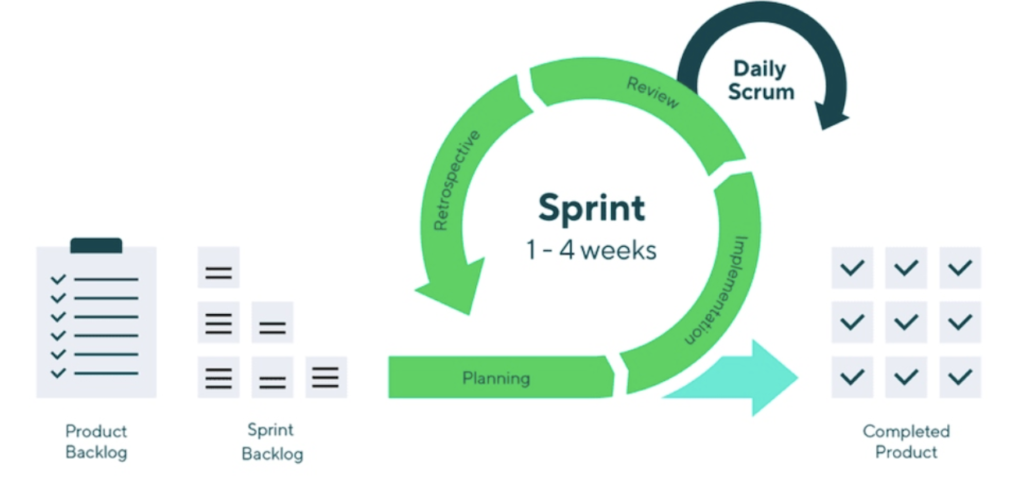In the process of realizing and transforming ideas into products, events in Scrum serve as the threads that connect the members of the Scrum team, including the Product Owner, the Development Team/Developers, and the Scrum Master.
Specifically, Scrum is defined by four events: Sprint Planning, Daily Scrum, Sprint Review, and Sprint Retrospective. Each event fulfills a different role but collaborates to create successful sprints and help the team achieve their set goals.
To grasp the essence of Scrum events, let’s first understand what a Sprint is. This is important because all four Scrum events take place within a Sprint.
What is a Sprint in Scrum Events?
According to the Scrum Guide, a Sprint is defined as:
“Sprints are the heartbeat of Scrum, where ideas are turned into value.”
In simple terms, a Sprint is a short time frame within a project. Scrum views this period as a small project itself. Sprints play the role of a heartbeat in Scrum, continuously generating value and gathering feedback as a basis for the next Sprint. A new Sprint begins immediately after the conclusion of the previous Sprint.
Sprints are time-boxed, with a length of no more than one month, and remain consistent throughout the development process. If a Sprint is too long, the Sprint Goal may become less suitable, and complexity may arise, leading to increased risks.

Notes on Sprints:
- No changes are allowed that would affect the Sprint Goal.
- The composition of the Development Team remains unchanged.
- The quality goal should not be compromised.
- The scope can be clarified and renegotiated between the Product Owner and the Development Team.
Sprint includes Planning, Implementation, Review, and Retrospective which can also be understood as the Scrum Events. Detailed information about these 4 steps of the Sprint is presented in the following paragraphs.
Scrum Events
Sprint Planning
This event occurs at the beginning of each Sprint and aims to plan the work for the entire Sprint. The plan created during this meeting is the result of collaboration among all members of the Scrum team.
The Sprint Planning session addresses the following three topics:
- What is the Sprint Goal?
- What can be completed within the Sprint?
- What needs to be done to complete the selected work?
The Sprint Planning session has a maximum time limit of 8 hours for a one-month Sprint. For shorter Sprints, this event will be shorter.
Daily Scrum
This is a short daily meeting with a timebox of no more than 15 minutes. The purpose of the Daily Scrum is to inspect the progress toward the Sprint Goal and make changes to the Sprint Backlog if necessary, by adjusting the planned work.
The Daily Scrum is encouraged to be held at a fixed time and location. The timing can be chosen by the team. The important thing is to ensure that this event always takes place at the chosen time to create a habit and prevent the Daily Scrum from becoming a complex event.
Sprint Review

The Sprint Review is an event that takes place at the end of the Sprint to inspect and adapt the product being built. The event consists of two main activities: product demonstration and discussion about the product’s status, future direction, and necessary adjustments.
The purpose of the Sprint Review is to examine the outcomes of the Sprint and identify adaptations for the future. The Sprint Review has a maximum time limit of four hours for a one-month Sprint. For shorter Sprints, this event will be shorter.
Sprint Retrospective – Improving the Sprint
The Sprint Retrospective is an event that takes place immediately after the Sprint Review and aims to inspect and adapt the working process. It provides an opportunity for the Scrum team to reflect on the work process of a Sprint and identify necessary improvements to enhance the quality and effectiveness in the following Sprints.
The Sprint Retrospective is time-boxed to three hours for a one-month Sprint. For shorter Sprints, the time can be shorter, around 45 minutes for a one-week Sprint.
Why Scrum requires too many meetings?
The answer is: No.
Although each Scrum event requires the participation of team members, and on average, each team member will spend about one hour per day attending these events, each event has a clear purpose to enhance work efficiency and minimize the need for non-defined meetings in Scrum.

Thanks to these “meetings” that maintain a rhythm, such as the Daily stand-up meeting and weekly meetings like Sprint Planning, Sprint Review, and Retrospective, the workflow, whether in the office or remote, will continue to progress steadily toward the team’s and the entire company’s weekly, monthly, and quarterly goals.
Read the related article: Understand Scrum Artifacts – Creating in Scrum
